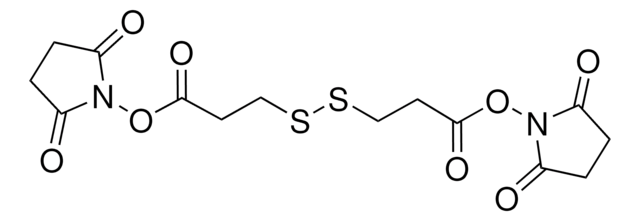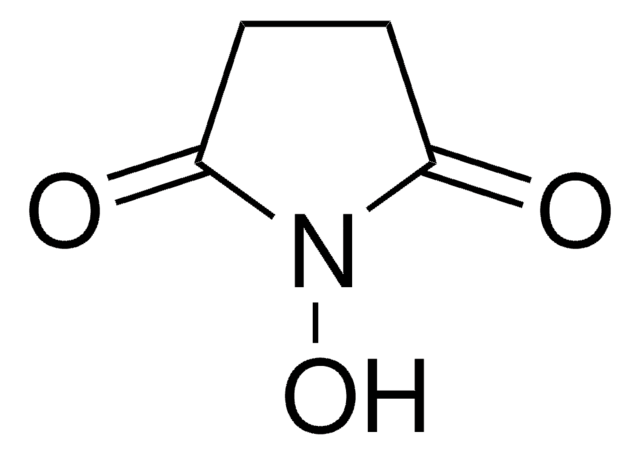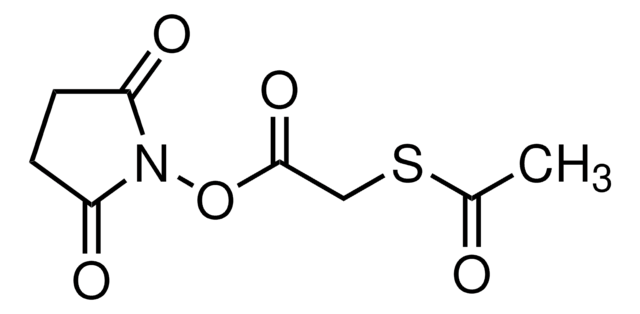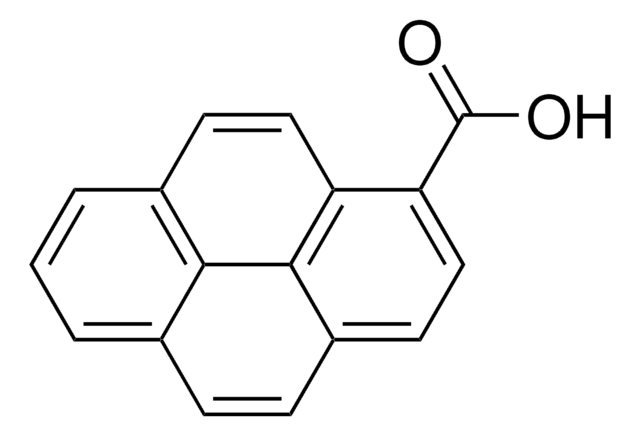All Photos(1)
Synonym(s):
3-(2-Pyridyldithio)propionate hydrazide, 3-[(2-Pyridyl)dithio]propionohydrazide
Empirical Formula (Hill Notation):
C8N3S2OH11
CAS Number:
Molecular Weight:
229.32
MDL number:
UNSPSC Code:
12352125
PubChem Substance ID:
NACRES:
NA.22
Recommended Products
Assay
≥95%
Quality Level
form
powder
mol wt
229.32
reaction suitability
reagent type: cross-linking reagent
storage condition
desiccated
solubility
DMSO or DMF: soluble
functional group
hydrazide
shipped in
ambient
storage temp.
2-8°C
SMILES string
NNC(CCSSC1=NC=CC=C1)=O
InChI
1S/C8H11N3OS2/c9-11-7(12)4-6-13-14-8-3-1-2-5-10-8/h1-3,5H,4,6,9H2,(H,11,12)
InChI key
NITXODYAMWZEJY-UHFFFAOYSA-N
Related Categories
General description
The PDPH is a heterobifunctional crosslinker containing sulfhydryl-reactive pyridyldithiol and carbonyl-reactive hydrazide moieties. Pyridyldithiols react with free sulfhydryls (-SH) to form disulfide bonds. Hydrazide groups react with carbonyls (aldehydes and ketones) to form stable hydrazone bonds. Aldehyde groups can be created by periodate-oxidation of sialic acid and other sugar components of glycoprotein polysaccharides. Thus, PDPH is useful for conjugating glycoproteins and sulfhydryl-containing peptides or proteins. Likewise, PDPH is useful as a sulfhydryl-addition reagent for glycoproteins and other carbohydrates; after reaction of the hydrazide to an oxidized carbohydrate, the pyridyldithiol group can be cleaved by a reducing agent to expose a sulfhydryl group. Yet another application for PDPH is to react the primary amine of the hydrazide moiety to a carboxyl group using the crosslinker EDC.
Features and Benefits
- Reactive groups: pyridyldisulfide and hydrazide
- Reactive toward: sulfhydryl groups and carbonyl (aldehyde) groups
- Short (9.2A), sulfhydryl-to-aldehyde crosslinker with disulfide bond spacer arm (cleavable)
- Pyridyldithiol group results in attachment to sulfhydryls via disulfide bond, which can be cleaved with DTT, TCEP or other reducing agents
- Hydrazide group conjugates to oxidized sugars of glycoproteins and carbohydrates
- Use sodium meta-periodate to oxidize glycosylation (e.g., sialic acid) to reactive aldehyde groups
- Use with EDC to conjugate primary amine of hydrazide group to carboxyl groups
Caution
This product is sensitive to moisture. The vial is packaged in a resealable bag with a desiccant to reduce exposure to moisture. After cold storage, equilibrate the vial to room temperature before opening to reduce condensation inside the vial. Make fresh solutions. Storage of stock solutions is not recommended. After use, return the vial to the resealable bag. Close the bag and store the product at the recommended temperature.
WGK
WGK 3
Flash Point(F)
Not applicable
Flash Point(C)
Not applicable
Certificates of Analysis (COA)
Search for Certificates of Analysis (COA) by entering the products Lot/Batch Number. Lot and Batch Numbers can be found on a product’s label following the words ‘Lot’ or ‘Batch’.
Already Own This Product?
Find documentation for the products that you have recently purchased in the Document Library.
D Pain et al.
Journal of immunological methods, 40(2), 219-230 (1981-01-01)
Protein A-peroxidase monoconjugate was prepared in solution using a heterobifunctional reagent, N-succinimidyl-3-(2-pyridyldithio)-propionate. The yield of the monoconjugate was much higher than that obtained with current methods. An immunoassay method was developed in which protein A-peroxidase monoconjugate served as a universal
G N Ranadive et al.
Nuclear medicine and biology, 20(6), 719-726 (1993-08-01)
We have developed a very efficient labeling technique for monoclonal antibodies with technetium-99m. Oxidation of sugar residues on the IgG class of antibodies leads to the generation of aldehyde groups which are further reacted with two newly developed hydrazide compounds.
Immobilization of glycoconjugates by their oligosaccharides: use of hydrazido-derivatized matrices.
D J O'Shannessy et al.
Analytical biochemistry, 191(1), 1-8 (1990-11-15)
D J O'Shannessy et al.
Immunology letters, 8(5), 273-277 (1984-01-01)
A novel method is described for the biotinylation of immunoglobulins. The procedure relies on the generation of reactive aldehydes on the carbohydrate moieties of the immunoglobulin by oxidation with sodium periodate and subsequent reaction with biotin hydrazide. The method is
Our team of scientists has experience in all areas of research including Life Science, Material Science, Chemical Synthesis, Chromatography, Analytical and many others.
Contact Technical Service![LC-SPDP (succinimidyl 6-[3(2-pyridyldithio)propionamido]hexanoate)](/deepweb/assets/sigmaaldrich/product/structures/300/586/d95fd80c-e201-4b0b-8aee-31e109c2ff41/640/d95fd80c-e201-4b0b-8aee-31e109c2ff41.png)
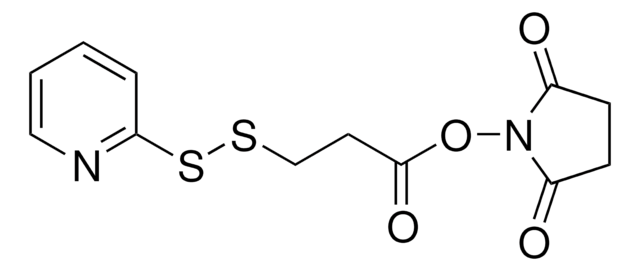

![Sulfo-LC-SPDP (sulfosuccinimidyl 6-[3′-(2-pyridyldithio)propionamido]hexanoate)](/deepweb/assets/sigmaaldrich/product/structures/266/633/e2a263be-4bd3-4fcf-89c4-75b5e2bd829c/640/e2a263be-4bd3-4fcf-89c4-75b5e2bd829c.png)


